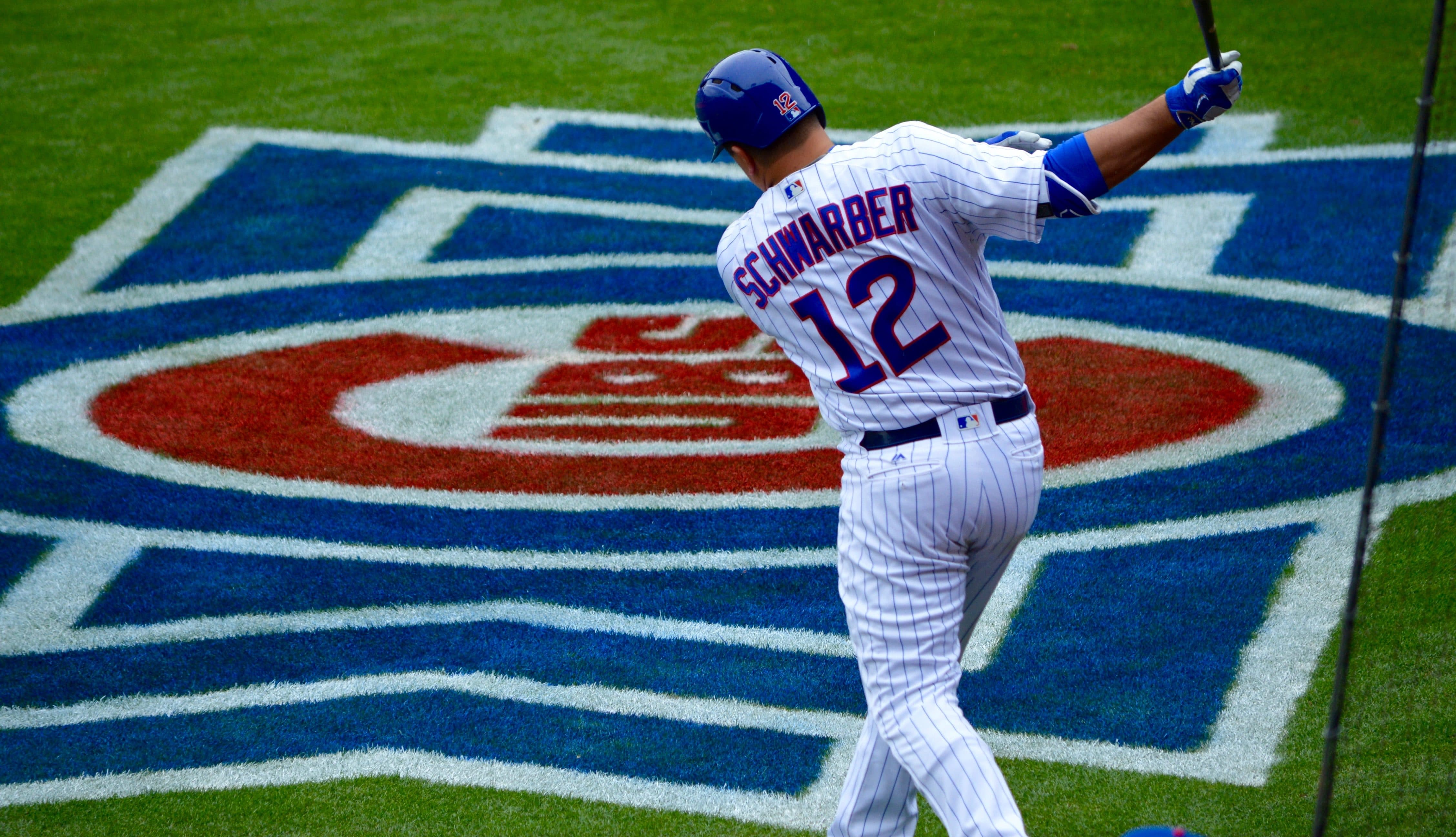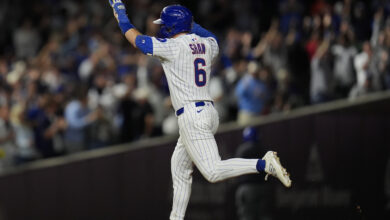
How Kyle Schwarber Can Adjust When He Steps in a Big Pile of Shift
Kyle Schwarber is slotted in as the Cubs’ leadoff hitter, a managerial decision that has raised eyebrows and blood pressure readings alike over the last few weeks. Even the most staid members of the baseball cognoscenti looked up — ableit briefly — from their copies of the Baseball Prospectus 2017 annual when the news was confirmed last week.
Most of the rabble seems to come down to the idea of not wanting to give The Round Mound of Re-pound too many bases-empty at-bats, a concept that is pretty sound on the surface. I’d counter with the idea that Schwarber’s power could actually tip the scales in the Cubs’ favor early, whether we’re talking about probability or psychology. Can you imagine being a pitcher and having to face War Bear, Kris Bryant, and Anthony Rizzo to open the game?
My thoughts were backed up by at least one lineup model that showed the Cubs scoring 8 more runs (!!!) with Schwarber at the top of the order than they would would him in the four-hole. Admittedly, that modeling was produced by Brendan Miller, one of Cubs Insider’s other lead writers. So, you know, season with appropriate salt before chewing that over.
Something that came up in one of the comments to an earlier piece on this topic, though, presented a new wrinkle to the quandary: Hitting against a shift more often. Schwarber batting leadoff means fewer at-bats with men on base, which affords more opportunities for defenses to change their alignment in order to combat him without concern for holding runners.
Before we get into that as it specifically relates to Schwarber, I’d like to draw your attention to an excellent piece from FanGraphs’ Eno Sarris in which the author asks whether baseball may have reached a saturation point when it comes to the increasing popularity of the shift. Below is a chart from said post, along with a brief excerpt for the sake of context.
| Year | Shift wOBABIP | No Shift wOBABIP |
|---|---|---|
| 2013 | 0.280 | 0.294 |
| 2014 | 0.288 | 0.294 |
| 2015 | 0.286 | 0.291 |
| 2016 | 0.292 | 0.297 |
The league has improved against the shift! The shift is dead! Or, wait: the league has actually improved as a whole over this timeframe, and the difference between the two is still about the same. And every team would take a .292 wOBA against over a .297 number. Long live the shift.
Still, if you poke around a little more, there’s evidence that the shift might be providing less value in the past. Sure, total shifts went up last year, again, but that doesn’t mean that we’re still seeing the same growth we’ve seen over the last few years.
We probably haven’t yet reached the high-water mark, that moment when the league discovers it has been shifting too often. Peak shift hasn’t happened yet. But maybe we’re getting closer to that day. Non-traditional shifts are down, at least, and the types of hitters we’re seeing shifted are getting closer to less ideal.
Now that we’ve taken a look at how the league as a whole is adjusting to the shift, let’s get back to Schwarber in particular. I should note before we get started here that this is highly imperfect and somewhat speculative. The War Bear we saw as a rookie is not the same creature who emerged from a six-month slumber to rake in the World Series. As such, we’re left with an incomplete picture of who he’ll be as a hitter moving forward.
What we do know is that traditional aging/production models show that a hitter’s plate discipline generally improves over time, which should lead to better contact rates. For someone like Schwarber, that could very well mean an increase in the 17.3 percent line-drive rate he posted as a rookie, not to mention decreases in ground-ball and/or fly-ball rates in the low 40’s.
The first of those numbers is the most important when it comes to beating the shift, or any defensive alignment for that matter. Line drives are generally indicative of better contact and are more likely to land for hits. Of course, lofting a moonshot to the top of a scoreboard or into a river are perfectly acceptable outcomes too. As we saw last year with Kris Bryant, a trend toward more liners can have dramatic results.
A hitter who’s able to keep the ball of the ground consistently is pretty well inoculated against strategic defensive alignments because he can hit it where they ain’t.
“The Ted Williams approach was to hit it hard and hit it in the air,” Mike Bryant shrared with CI when talking about how his son improved from his rookie year. “Ted said, ‘What shift?’ He said, ‘I don’t care about shifts.’ The way he beat the shift is to hit it in the air.”
The Splendid Splinter is essentially the archetype when it comes to the science of hitting, so I’m not trying to say Schwarber can be that guy. What I am saying is that the burly left-handed batter can take some of Williams’ philosophies to heart, particularly if defenses do indeed cheat him a bit more on the right side of the field. Then again, he seems to have done pretty well in that regard already.
In 88 at-bats against a shift — not nearly enough to establish a firm statistical foundation, but it’s all we’ve got — Schwarber has an .852 OPS, a .370 wOBA, and a 136 wRC+, all of which are slightly higher than his overall career numbers. He has also gone to center and left in 55.7 percent of those situations, which is again higher than his career mark of 52.6 percent. All of which is to say that the dude appears to have a pretty good handle on how to combat different alignments.
We now arrive at my final point, which involves Schwarber’s ability to handle outside pitches. This is important for a couple different reasons, the first of which is that he’s able to proactively beat the shift by taking those pitches up the middle or the other way. I suppose that’s a little redundant in the face of the information provided above, but there’s a bit more nuance to it as well.
Baseball is a game of adjustments, and Schwarber appears able to remain one step ahead of opposing pitchers when it comes to future changes in how they approach him. You see, the above situation would deal primarily with mistakes made when facing War Bear with a shift on. In those instances, pitchers would want to stay inside and down to get him to beat the ball on the ground to the right side, so outside pitches would generally be the result of poor location.
If, however, the powerful leadoff man proves adept at beating the shift, teams will have to change tack. That means working him outside and forcing him to go oppo more often, which is where we would really see those elevated ISO numbers from the most recent link come into play. Literally.
In conclusion, the publicly available numbers (most of which I culled from FanGraphs) give me the utmost confidence in Schwarber’s ability to handle the increased number of shifts he’s likely to face in his new role. What’s more, his prowess against outside pitches speaks favorably of his relative immunity to changes in pitching and defensive strategy in the future. Of course, you need temper all this with the knowledge that a) we’re drawing from a small sample; and b) I’m a noted War Bear honk.
All things considered, there can be no final assessments of this particular facet of the Cubs’ lineup configuration until we’ve seen it in action. And I’m talking about more than just a few Spring Training games. Or, you know, we can just call it a failed gimmick the first time Schwarber grounds out to the shortstop or second baseman playing shallow right.

